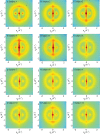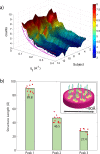The structure of people's hair
- PMID: 25332846
- PMCID: PMC4201279
- DOI: 10.7717/peerj.619
The structure of people's hair
Abstract
Hair is a filamentous biomaterial consisting mainly of proteins in particular keratin. The structure of human hair is well known: the medulla is a loosely packed, disordered region near the centre of the hair surrounded by the cortex, which contains the major part of the fibre mass, mainly consisting of keratin proteins and structural lipids. The cortex is surrounded by the cuticle, a layer of dead, overlapping cells forming a protective layer around the hair. The corresponding structures have been studied extensively using a variety of different techniques, such as light, electron and atomic force microscopes, and also X-ray diffraction. We were interested in the question how much the molecular hair structure differs from person to person, between male and female hair, hair of different appearances such as colour and waviness. We included hair from parent and child, identical and fraternal twins in the study to see if genetically similar hair would show similar structural features. The molecular structure of the hair samples was studied using high-resolution X-ray diffraction, which covers length scales from molecules up to the organization of secondary structures. Signals due to the coiled-coil phase of α-helical keratin proteins, intermediate keratin filaments in the cortex and from the lipid layers in the cell membrane complex were observed in the specimen of all individuals, with very small deviations. Despite the relatively small number of individuals (12) included in this study, some conclusions can be drawn. While the general features were observed in all individuals and the corresponding molecular structures were almost identical, additional signals were observed in some specimen and assigned to different types of lipids in the cell membrane complex. Genetics seem to play a role in this composition as identical patterns were observed in hair from father and daughter and identical twins, however, not for fraternal twins. Identification and characterization of these features is an important step towards the detection of abnormalities in the molecular structure of hair as a potential diagnostic tool for certain diseases.
Keywords: Alpha helix; Cell membrane complex; Coiled-coil proteins; Human hair; Intermediate filament; Keratin; Molecular structure; X-ray diffraction.
Figures







References
-
- Astbury WT, Sisson WA. X-ray studies of the structure of hair, wool, and related fibres. III. The configuration of the keratin molecule and its orientation in the biological cell. Proceedings of the Royal Society of London. Series A, Mathematical and Physical Sciences. 1935;150:533–551. doi: 10.1098/rspa.1935.0121. - DOI
-
- Astbury WT, Street A. X-ray studies of the structure of hair, wool, and related fibres. I. General. Philosophical Transactions of the Royal Society of London. Series A, Containing Papers of a Mathematical or Physical Character. 1932;230:75–101. doi: 10.1098/rsta.1932.0003. - DOI
-
- Astbury WT, Woods HJ. X-ray studies of the structure of hair, wool, and related fibres. II. The molecular structure and elastic properties of hair keratin. Philosophical Transactions of the Royal Society of London. Series A, Containing Papers of a Mathematical or Physical Character. 1934;232:333–394. doi: 10.1098/rsta.1934.0010. - DOI
LinkOut - more resources
Full Text Sources
Other Literature Sources

